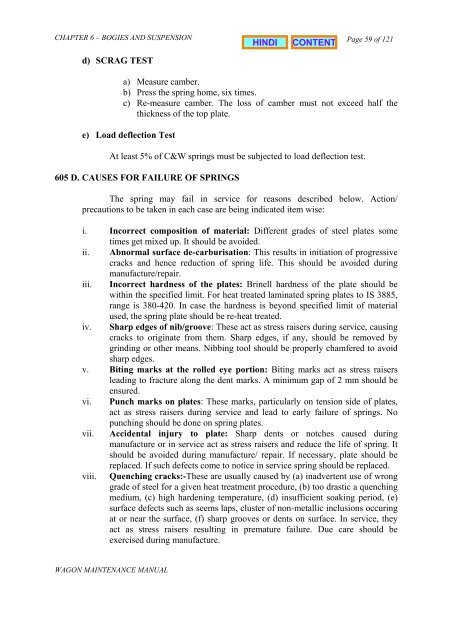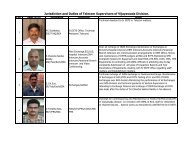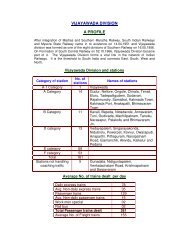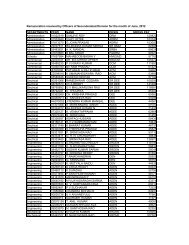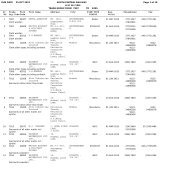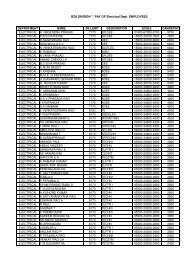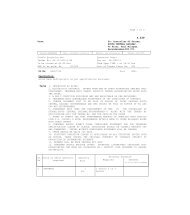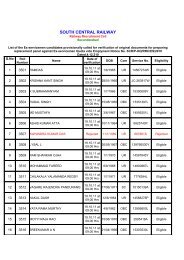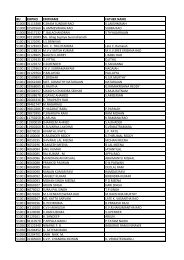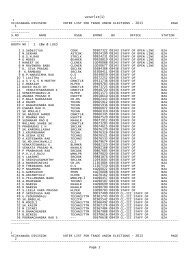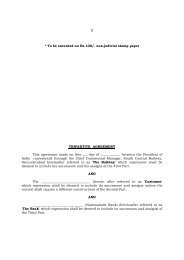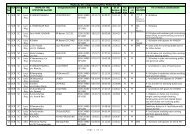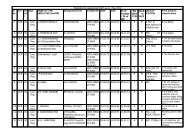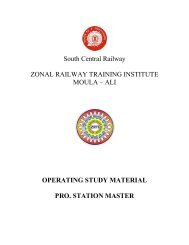BOGIES AND SUSPENSION - South Central Railway
BOGIES AND SUSPENSION - South Central Railway
BOGIES AND SUSPENSION - South Central Railway
Create successful ePaper yourself
Turn your PDF publications into a flip-book with our unique Google optimized e-Paper software.
CHAPTER 6 – <strong>BOGIES</strong> <strong>AND</strong> <strong>SUSPENSION</strong><br />
d) SCRAG TEST<br />
WAGON MAINTENANCE MANUAL<br />
Page 59 of 121<br />
a) Measure camber.<br />
b) Press the spring home, six times.<br />
c) Re-measure camber. The loss of camber must not exceed half the<br />
thickness of the top plate.<br />
e) Load deflection Test<br />
At least 5% of C&W springs must be subjected to load deflection test.<br />
605 D. CAUSES FOR FAILURE OF SPRINGS<br />
The spring may fail in service for reasons described below. Action/<br />
precautions to be taken in each case are being indicated item wise:<br />
i. Incorrect composition of material: Different grades of steel plates some<br />
times get mixed up. It should be avoided.<br />
ii. Abnormal surface de-carburisation: This results in initiation of progressive<br />
cracks and hence reduction of spring life. This should be avoided during<br />
manufacture/repair.<br />
iii. Incorrect hardness of the plates: Brinell hardness of the plate should be<br />
within the specified limit. For heat treated laminated spring plates to IS 3885,<br />
range is 380-420. In case the hardness is beyond specified limit of material<br />
used, the spring plate should be re-heat treated.<br />
iv. Sharp edges of nib/groove: These act as stress raisers during service, causing<br />
cracks to originate from them. Sharp edges, if any, should be removed by<br />
grinding or other means. Nibbing tool should be properly chamfered to avoid<br />
sharp edges.<br />
v. Biting marks at the rolled eye portion: Biting marks act as stress raisers<br />
leading to fracture along the dent marks. A minimum gap of 2 mm should be<br />
ensured.<br />
vi. Punch marks on plates: These marks, particularly on tension side of plates,<br />
act as stress raisers during service and lead to early failure of springs. No<br />
punching should be done on spring plates.<br />
vii. Accidental injury to plate: Sharp dents or notches caused during<br />
manufacture or in service act as stress raisers and reduce the life of spring. It<br />
should be avoided during manufacture/ repair. If necessary, plate should be<br />
replaced. If such defects come to notice in service spring should be replaced.<br />
viii. Quenching cracks:-These are usually caused by (a) inadvertent use of wrong<br />
grade of steel for a given heat treatment procedure, (b) too drastic a quenching<br />
medium, (c) high hardening temperature, (d) insufficient soaking period, (e)<br />
surface defects such as seems laps, cluster of non-metallic inclusions occuring<br />
at or near the surface, (f) sharp grooves or dents on surface. In service, they<br />
act as stress raisers resulting in premature failure. Due care should be<br />
exercised during manufacture.


